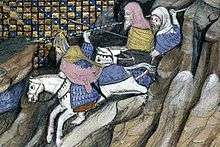Art Óg mac Murchadha Caomhánach
| Art Óg | |||||
|---|---|---|---|---|---|
| Mac Murchadha, King of Laighin | |||||
 MacMurrough-Kavanagh riding | |||||
| Reign | 1375 – c. 1417 | ||||
| Predecessor | Donnchadh mac Muircheartaigh | ||||
| Successor | Donnchadh mac Airt Mhóir | ||||
| Born |
1357 Unknown | ||||
| Died |
c. 1417 Ferns, County Wexford, Ireland or New Ross, County Wexford, Ireland | ||||
| Burial | St Mullin's, County Carlow, Ireland | ||||
| Spouse | Elizabeth le Veel | ||||
| Issue | Donnchadh, Gerald (Gearalt), Diarmuid Lamhdearg | ||||
| |||||
| Irish | Art mac Airt Mac Murchadha Caomhánach | ||||
| English | Art MacMurrough-Kavanagh | ||||
| House | Mac Murchadha-Caomhánach | ||||
| Father | Art Mór Mac Murchadha Caomhánachh | ||||

Art Óg Mac Murchadha Caomhánach (anglicized Art MacMurrough-Kavanagh, Art MacMorrough, Art MacMorrow-Kavanagh, or Art MacMorrow;[1] 1357 – c. 1417) was an Irish king who is generally regarded as the most formidable of the later Kings of Leinster. He revived not only the royal family's prerogatives, but also their lands and power. During his 42-year reign, he dominated the Anglo-Norman settlers of Leinster.
MacMurrough-Kavanagh's dominance of the province and its inhabitants, both Gaelic and Hiberno-Norman, was deemed sufficiently detrimental to the colony that Richard II of England spent much of the years 1394 and 1395 sparring with him. While MacMurrough-Kavanagh did eventually submit to Richard, he renounced this fealty on Richard's departure and made much of his kingdom a death trap for any invading English or Anglo-Irish forces. The Crown accordingly dealt with him cautiously and he was granted an amnesty in 1409.
MacMurrough-Kavanagh married Elizabeth le Veel, widow of Sir John Staunton of Clane. She was the only daughter of Sir Robert le Veel, and through her father the heiress of the Anglo-Norman barony of Norragh. Such a racial intermarriage violated the Statutes of Kilkenny and the Crown thus forfeited Elizabeth's lands, which later became one of the causes of her husband's enmity to the English. They had three sons: Donnchadh, King of Leinster, Diarmuid Lamhdearg, and Gerald, Lord of Ferns. Elizabeth's estates later passed to the Wellesley family, who were descendants of her daughter, Elizabeth, by her first husband, Sir John Staunton of Clane; the Wellesleys were ancestors of the Duke of Wellington.
MacMurrough-Kavanagh died soon after Christmas 1417, perhaps in his bed in Ferns, or perhaps was poisoned in New Ross—accounts differ.[2][3]
MacMurrough-Kavanagh's descendants include 19th century Irish politician Arthur MacMurrough Kavanagh.
The 1885 historical novel Art M'Morrough O'Cavanagh, Prince of Leinster: An Historical Romance of the Fourteenth Century by M. L. O'Byrne is a loosely biographical account of his life, written from a nationalist perspective.
See also
References
- ↑ Ryan, John. The History and Antiquities of the County of Carlow.
- ↑ Curtis, Edmund (2013-05-07). A History of Medieval Ireland (Routledge Revivals): From 1086 to 1513. Routledge. ISBN 9781136298707.
- ↑ http://www.libraryireland.com/JoyceHistory/Kavanagh.php
- Annals of the Four Masters online
- Francis John Bryne, Irish Kings and High Kings (Dublin, 1973)
- Emmett O'Byrne, War, Politics and the Irish of Leinster 1156-1606 (Dublin, 2003)

External links
- Ireland's Wars, How Art MacMurragh Brought Down The English Monarchy at Never Felt Better